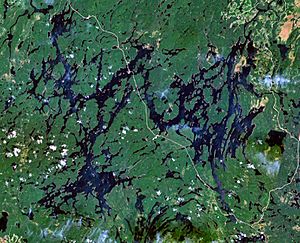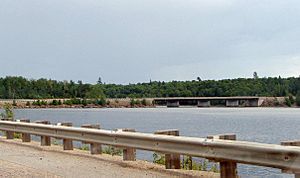Dozois Reservoir facts for kids
Quick facts for kids Dozois Reservoir |
|
|---|---|
 |
|
| Location | Réservoir-Dozois, La Vallée-de-l'Or Regional County Municipality, Quebec |
| Coordinates | 47°30′00″N 77°05′00″W / 47.50000°N 77.08333°W |
| Type | Artificial |
| Primary inflows | Ottawa River |
| Primary outflows | Ottawa River |
| Basin countries | Canada |
| Max. length | 61 km (38 mi) |
| Max. width | 34 km (21 mi) |
| Surface area | 319 km2 (123 sq mi) |
| Surface elevation | 336.80 m (1,105.0 ft) to 345.95 m (1,135.0 ft) |
The Dozois Reservoir (which is called Réservoir Dozois in French) is a large, man-made lake in the middle of Quebec, Canada. It is completely inside a special area called Réservoir-Dozois. This area is also part of the La Vérendrye Wildlife Reserve.
This big reservoir is about 10 kilometers west of the Cabonga Reservoir. It is also about 15 kilometers east of Great Victoria Lake. Rivers like the Chochocouane, Capitachouane, and Ottawa River flow into it. You can easily reach the reservoir from Quebec Route 117.
Contents
How Was Dozois Reservoir Created?
The Dozois Reservoir was formed when people built a dam on the Ottawa River. This happened in 1949. The dam is called the Bourque Dam.
Flooding and New Lakes
When the dam was built, the water level rose a lot. This caused many smaller lakes and bays to become one large reservoir. Some of the places that were flooded include Lake Soulier and Déléage Bay. The original Lake Dozois was also covered by the new, bigger reservoir.
Who Was Nazaire-Servule Dozois?
The reservoir got its name from the original Lake Dozois. That lake was named after a person named Nazaire-Servule Dozois. He lived from 1859 to 1932. He was a missionary, which means he traveled to spread religious teachings. He worked in a region called Témiscamingue. He also held an important position as an Assistant General for a group called the Oblates from 1904 to 1932.
When Did the Name Change?
The name "Lake Dozois" has been used since around 1913. Before that, on maps from 1911, it was called "Birch Lake."



